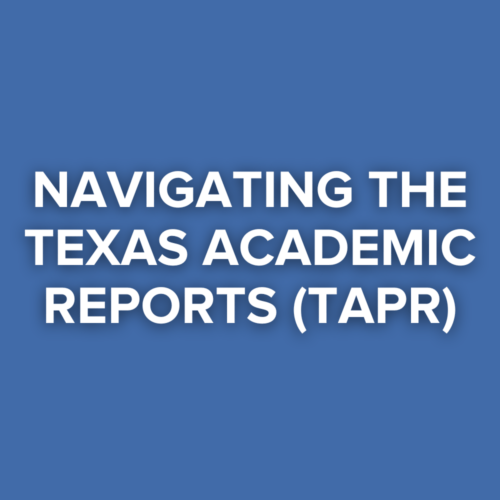The Texas Academic Performance Reports (TAPR) serve as a comprehensive compass for evaluating the educational landscape in Texas. Released annually, these reports meticulously compile a wealth of data on academic performance and other key metrics like attendance and teachers, offering insights into each school and district across Texas. In this blog, we’ll dive into the basics of TAPR, shedding light on its significance and exploring some key highlights from the released data.
Understanding TAPR
The Texas Academic Performance Reports are a vital resource for educators, policymakers, and the public to assess the effectiveness of educational initiatives and identify areas for improvement. The reports go beyond test scores, presenting a comprehensive view of educational performance by breaking down data based on student groups, including ethnicity and socioeconomic status. TAPR also presents data on other important topics like teacher workforce, attendance and absenteeism, and college, career, and military readiness (CCMR).
Key Components of TAPR
Academic Performance
TAPR provides a detailed analysis of student performance on standardized tests, showcasing how well schools and districts are meeting academic standards. This section is crucial for gauging overall educational effectiveness and identifying areas where targeted interventions may be needed.
Disaggregated Data
One of the strengths of TAPR lies in its commitment to transparency. The reports disaggregate data, meaning it is broken down into specific subgroups, including ethnicity and socioeconomic status. This enables stakeholders to identify gaps and implement targeted strategies to address disparities among student groups.
Staff Information
TAPR doesn’t stop at student performance; it also offers insights into the educators shaping the learning environment. Reports include information on school and district staff, highlighting the experience, qualifications, and diversity of the teaching workforce.
Other Topics
TAPR also includes reports on many other topics, including high school graduation rates and the college, career, and military readiness (CCMR) of those graduates. CCMR incorporates many metrics–including SAT/ACT scores, participation in AP/IB coursework, and attainment of career-oriented certifications. This helps us better understand how schools are doing at ensuring students graduate with the skills and knowledge necessary to succeed in their lives after high school. In addition, TAPR provides insights into topics like attendance and chronic absenteeism, highlighting trends in how consistently (or inconsistently) students are in school every day.
The Texas Academic Performance Reports are more than just an annual release of statistics; they are a tool for transformation. By providing a comprehensive overview of educational performance, TAPR empowers stakeholders to make informed decisions in a host of areas, fostering an environment where every student has the opportunity to thrive.
Initial Findings
Attendance and Enrollment
School districts continue to face enrollment declines, alongside a drastic increase in the percentage of students considered chronically absent, or missing at least 10% of school days. In some districts as many as 4 in 10 students were considered chronically absent. Expectedly, being in school is a critical component to academic success. Even more, enrollment numbers and attendance rates both impact funding allocations. Read our enrollment and attendance analyses to learn more about how specific student demographic groups are most impacted.
College, Career, and Military Readiness
The Texas Education Agency (TEA) has established College, Career, and Military Readiness (CCMR) standards with the goal of ensuring students graduate high school with the skills and knowledge needed to be successful in their postsecondary lives. While Houston-region districts have strong high school graduation rates, about 1 in 3 graduates were not considered college, career, or military ready. Read our analysis to learn more about how a smaller proportion of graduates are enrolling in college and more are attaining industry-based certifications.
Kindergarten Readiness
School districts are required to offer tuition-free, Pre-K programs to eligible students. The impact of Pre-K programs is clear. Students who were eligible and attended Pre-K were 2.5 times more likely to be kindergarten ready. The impact held true across Black, Hispanic, Emergent Bilingual (EB), and Economically Disadvantaged (EcoDis) student groups. Still, 6 in 10 eligible students are not yet enrolled in programs. Read our analysis to learn more about the impact of Pre-K and recommendations.
Teacher Workforce
The teacher workforce data provides us insight to teacher demographics, retention and turnover rates, and salaries – helping us to better understand more about who is in front of students. Teacher turnover continues to be high for districts, resulting in a heavier reliance on first-year teachers and decline in teacher experience and tenure. Read our analysis to learn more about these trends and what districts can do to retain and reward effective teachers through opportunities like the Teacher Incentive Allotment.
Over the next few months, be on the lookout for Good Reason Houston to release additional content analyzing the data and providing a more comprehensive understanding of critical issues that shape the educational experiences and outcomes for students and families.




